
St Michael's Cemetery is a Catholic burial ground in the Rivelin Valley area of Sheffield, South Yorkshire, England. The cemetery stands on a steep hillside on the south side of Rivelin Valley Road at its junction with Rivelin Road and Hollins Lane.

St Michael's Cemetery is a Catholic burial ground in the Rivelin Valley area of Sheffield, South Yorkshire, England. The cemetery stands on a steep hillside on the south side of Rivelin Valley Road at its junction with Rivelin Road and Hollins Lane.
In the early 1860s there was no consecrated ground for the burial of Catholic people within the boundaries of Sheffield. This came about largely because of past persecution resulting from the English Reformation of the 16th century. Father Burke of St Vincent's Church on Solly Street in the city, being quite concerned about this began a search for a suitable burial ground and finally purchased an eight-acre site on a sloping hillside in Rivelin Glen. The plot of land was bought for £600 in the Spring of 1862 from Mr. Wilson of Loxley, a member of the famous Wilson family of snuff manufacturers. The site was quickly enclosed and walled off at a further cost of £250 and received official Government approval as a burial ground on 25 August 1862.
On 29 September 1862 (Michaelmas day) Robert Cornthwaite, Bishop of Beverley laid and consecrated the cornerstone of the original St Michael's chapel. When later writing about the laying of the cornerstone, Father Burke revealed the names of some of the benefactors who helped pay for the cemetery. He wrote, "a few humble Irish Catholics who had by good conduct and honest industry, realised a little property, offered to supply £500 or £600 to purchase a graveyard". They were Michael Monaghan, Lawrence Brown and James Callaghan. A further £200 was donated by a Mr. Hodgkinson "a worthy English gentleman" and these four along with Father Burke and Arnold Sutton of Revell Grange were named as trustees of the cemetery.

It is believed that the first interments in the new cemetery took place on 23 September 1862 when two young children Mary Mulvey, aged three and Catherine Hopkins, aged seven were buried at St Michael's. By the summer of 1863 the work on the cemetery and its chapel were complete with the final cost coming to £1,400. On 26 October 1863 the chapel was blessed by Father Burke and dedicated to St Michael the Archangel. In December of that year the St Vincent Catholic Young Men's Society donated a statue of Saint Patrick and a set of bas relief Stations of the Cross which were erected in the chapel.
The original chapel was always meant to a temporary building and in 1877 a new permanent building was erected at a cost of £2,000, which was donated by George Harvey Foster, a local businessman in the tailoring trade, and his wife Mary Ann. This gift is marked by a marble plaque on the right (epistle) side of the chapel. The Foster family also have a family crypt close to the chapel, which is marked by an ornate pointed monument. The new chapel was opened and blessed, again by Robert Cornthwaite (now Bishop of Leeds), on 11 December 1877. [1]
The chapel is in the Early English style and was designed by the architects Messrs Hadfield and Son with Mr. M.J. Dowling used as the contractor. It is built of dressed Greenmoor wallstone with Worrall stone dressing, internally it is 22 feet wide and 72 feet long, the roof is covered by Staffordshire tiles. At the chapel's western end is a sixty foot high bell turret in which hangs a five cwt bell by Mears of London. The chapel was designated a Grade II listed building in December 1984. [2] The cemetery's most notable grave is the Walsh monument, which is a Grade II listed structure. This is a vault and memorial constructed for the Walsh family, it consist of mostly granite and marble with decorative cast-iron railings and a 1.5-metre-high (4.9 ft) figure on top. [3]
The altar is made of polished marble and veined alabaster and has a figure of the dead Christ lying beneath it, sculpted by Messrs R. L. Boulton & Sons of Cheltenham. The chancel has a floor made of patterned encaustic tiles. John Francis Bentley designed the three east windows which feature, The Risen Christ, The Blessed Virgin and St John, they were produced by the firm of Lavers, Barraud and Westlake. In 1884 the Foster family financed improvements to the interior to the tune of £430. These featured designs by Nathaniel Westlake and Matthew Hadfield and included the west window (in memory of Father James Fitzgerald), the Sienese crucifix and wall paintings of the four Resurrections. [4]
The cemetery contains the graves of 30 Commonwealth service personnel, registered and maintained by the Commonwealth War Graves Commission, 24 from World War I and 6 from World War II. [5]

The Cathedral Church of St Marie is the Roman Catholic cathedral in Sheffield, England. It lies in a slightly hidden location, just off Fargate shopping street, but signals its presence with a tall spire. It is an especially fine example of an English Roman Catholic Cathedral, with much fine interior decoration. Re-ordering of the Sanctuary following the Second Vatican Council, has been sensitive. There are several particularly notable side altars, as well as historic statues and painted tiles.

The River Rivelin is a river in Sheffield, South Yorkshire, England.
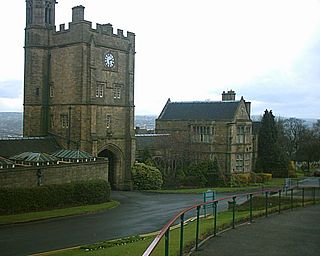
The City Road Cemetery is a cemetery in the City of Sheffield, England that opened in May 1881 and was originally Intake Road Cemetery. Covering 100 acres (40 ha) it is the largest and is the head office for all the municipally owned cemeteries in Sheffield. The cemetery contains Sheffield Crematorium, whose first cremation was on 24 April 1905.
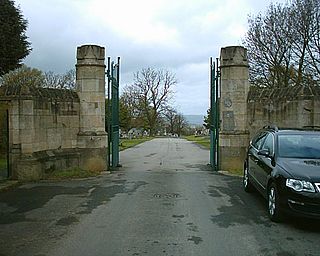
Crookes Cemetery is a cemetery between Crosspool and Crookes in the city of Sheffield, South Yorkshire, England. Its main entrance is on Headland Road with additional access from Mulehouse Road. It was opened in 1906, and covers 29 acres (120,000 m2). By 2009, over 29,000 burials had taken place since its opening.
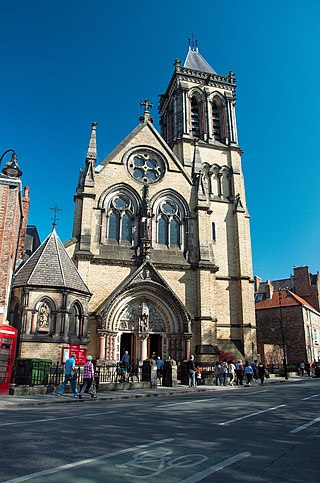
George Goldie was an English ecclesiastical architect who specialised in Roman Catholic churches.
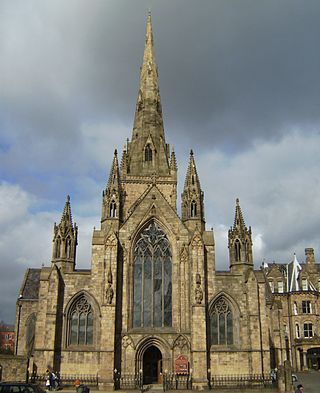
Matthew Ellison Hadfield was an English architect of the Victorian Gothic revival. He is chiefly known for his work on Roman Catholic churches, including the cathedral churches of Salford and Sheffield.

Queen's Road Cemetery is a cemetery in Croydon, England. It opened in 1861, and was followed in 1897 by the larger Croydon Cemetery in Mitcham Road. Both cemeteries are now managed by the London Borough of Croydon.

St Vincent's Church is a redundant Roman Catholic church situated on Solly Street at its junction with Hollis Croft in the centre of the City of Sheffield, South Yorkshire, England.
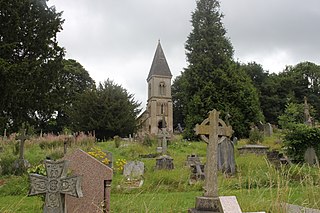
The Anglican Bath Abbey Cemetery, officially dedicated as the Cemetery of St Peter and St Paul, was laid out by noted cemetery designer and landscape architect John Claudius Loudon (1783–1843) between 1843 and 1844 on a picturesque hillside site overlooking Bath, Somerset, England.

Nathaniel Hubert John WestlakeFSA (1833–1921) was a 19th-century British artist specialising in stained glass.

The English coastal city of Brighton and Hove, made up of the formerly separate Boroughs of Brighton and Hove in East Sussex, has a wide range of cemeteries throughout its urban area. Many were established in the mid-19th century, a time in which the Victorian "cult of death" encouraged extravagant, expensive memorials set in carefully cultivated landscapes which were even recommended as tourist attractions. Some of the largest, such as the Extra Mural Cemetery and the Brighton and Preston Cemetery, were set in particularly impressive natural landscapes. Brighton and Hove City Council, the local authority responsible for public services in the city, manages seven cemeteries, one of which also has the city's main crematorium. An eighth cemetery and a second crematorium are owned by a private company. Many cemeteries are full and no longer accept new burials. The council maintains administrative offices and a mortuary at the Woodvale Cemetery, and employs a coroner and support staff.

Revell Grange is a Grade II listed English country house situated on Bingley Lane in the suburb of Stannington overlooking the Rivelin valley within the City of Sheffield, England. The house played an important role as a focal point of early Catholicism within the city and still houses a private chapel to this day.

St Mary Magdalen Roman Catholic Church, Mortlake, is a Roman Catholic church in North Worple Way, Mortlake, in the London Borough of Richmond upon Thames. The church is dedicated to Jesus' companion Mary Magdalene.

Wardsend Cemetery is a Victorian cemetery in the Owlerton district of Sheffield, England, consecrated by the Archbishop of York in 1859 and closed to legal burial in 1968.

The Monastery of The Holy Spirit, known locally as Kirk Edge Convent is a Carmelite monastery for nuns. It is situated on Kirk Edge Road between the villages of Worrall and High Bradfield within the boundaries of the City of Sheffield, England. It is one of 18 carmels in the United Kingdom. The building stands just within the Peak District at a height of 340 metres and has extensive views of the surrounding area.

St Catherine's Church is a Roman Catholic Parish church in Littlehampton, West Sussex, England. It was founded in 1862, built in stages afterwards and designed by Matthew Ellison Hadfield. It is situated on Beach Road backing on to St Catherine's Road in the centre of the town. It is a Gothic Revival church and a Grade II listed building.

St Patrick's Roman Catholic Cemetery is a heritage-listed closed cemetery on the corner of Pennant Hills Road and Church Street, North Parramatta, City of Parramatta, New South Wales, Australia. It is the earliest formalised Catholic cemetery in Australia, and was in use from 1824 to 1972. A central feature of this historic cemetery is the 1844 Gothic revival styled mortuary chapel, which is the oldest mortuary chapel in Australia. The cemetery was closed in 1972 and subsequently transferred to the City of Parramatta in 1975. It was added to the New South Wales State Heritage Register on 23 March 2012.
Mawer and Ingle was a company of architectural sculptors, based in Leeds, West Yorkshire, England, between 1860 and 1871. It comprised cousins Charles Mawer and William Ingle (1828–1870), and Catherine Mawer (1804–1877) who was mother of Charles and aunt of William. The group produced carvings on many Gothic Revival churches and their internal furnishings. They also worked on civic buildings, warehouses and offices. Many of these are now listed by Historic England, and many of the surviving buildings are within Yorkshire. Their work outside Yorkshire included Trent Bridge.

St Joseph's Church, Highgate is a parish of the Catholic Church on Highgate Hill, in the Diocese of Westminster, London. It was founded by the Passionist Congregation in 1858. It is a grade II listed building.

Ash Cemetery, also known as Emery Gates Cemetery on Church Road is the burial ground for the village of Ash in Surrey, England.